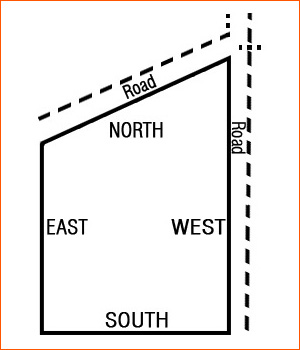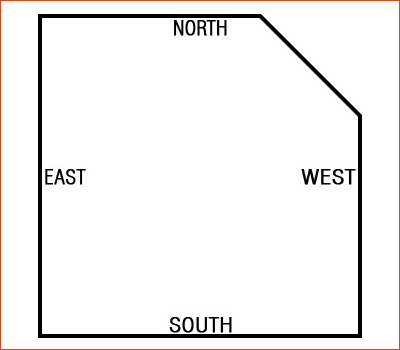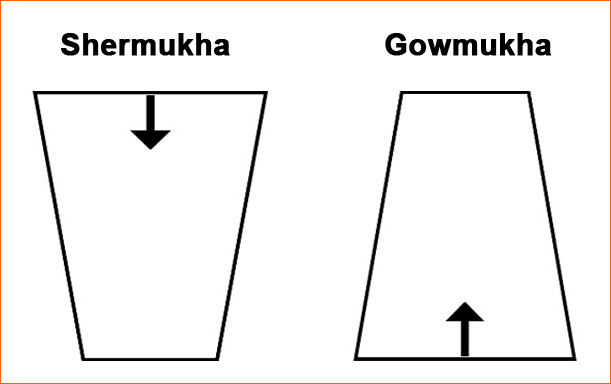Vastu Shastra
One should be very careful before taking any decision. Some basic points I have already told, now the main things that one should consider are.
- Orientation of plot
- Four side angles of the plot in respect to orientation.
- The length of the plot should be more in the North-South direction as compared to the East-West direction.

- If all the corner angles of the plot are 90 degrees, it is a good plot.
- The gowmukha plot is one that is narrower at the entrance and becomes broader as we go in. It is very auspicious.
- A plot with all corners 90 degrees having two sides’ road front and back is a good plot.
- A plot with four corners having 90 degrees angles with three sides of four sides’ roads is a very good plot.
- If the house is projected in any of either directions, then one should always consider the following rules.
- The North/East projection is good and is recommended.


- The South/East, South/West and North/West projections are not good sites and are not recommended according to Vastu but if one already has this kind of plot, it can be corrected.
- If you are seeing the plot which is cut in either direction, then it is not recommended.
- Now if the plot angles are not at 90 degrees, be sure about it whether it is ‘shermukha plot’ or ‘gowmukha plot’.

The shermukha plot is one that has a broader entrance and it becomes narrower as we go in. It is NOT at all recommended for the residence.
Usually, people believe that the South facing plot is not good and that these are all myths, it entirely depends upon the full orientation,
The entrance of the house depends on the zodiac sign of the owner. It is as follows.
- Kark ( Cancer)
Virchak (Scorpio ) EAST facing plot
Meen (Pisces) - Mithun (Gemini)
Kanya ( Virgo) SOUTH facing plot
Makar (Pisces) - Rishab (Taurus)
Tula ( Libra) WEST facing plot
Kumbh (Aquarius) - Mesh (Aries)
Singh ( Leo) NORTH facing plot
Dhanu (Sagittarius)
We Can Categorize The Doors In Seven Different Categories , Each Of Them Is Discussed Below.

Entry Doors

Interior Doors

Glass Doors

Paneled Doors

Metal Doors

French Doors

Carved Doors
We Can Categorize The Doors In Seven Different Categories , Each Of Them Is Discussed Below.

Aagney
It is the lord of fire and is positioned in the South-East direction.

Aap
Means water , which is one of the five elements that constituent our universe.

Aakash
Means Space , which is another element that constitutes our univers.

Atman
The individual consciousness.

Brahma
The creator of the universe.

Istaka
The brick , as known in the Vedic times.

Jiva
The soul.

Kalpadruma
The wishing tree.

Purusha
The consciousness, the life source.

Parmataman
The universal consciousness.

Prana
The life.

Prakriti
The nature.

Samadhi
( Sthiti) - To sit with folded legs on the ground in one posture for meditation.

Shankh
The counch , a sea shell through which the sound is produced and is mostly used in religious ceremonies.

Shrishti
Creation of the entire universe.

Sthapati
The architect , as known in the Vedic times.

Sutregrahi
The draughtsman , as known in the Vedic times.

Takshaka
The carpenter , as known in the Vedic times.

Vardhaki
The mason , as known in the Vedic times.

Aura
It is defined as luminous radiation, a radiant light around a person's head or body. The different colors appearing in the aura have been studied by physics, and various tints of each color suggest different characteristics.
